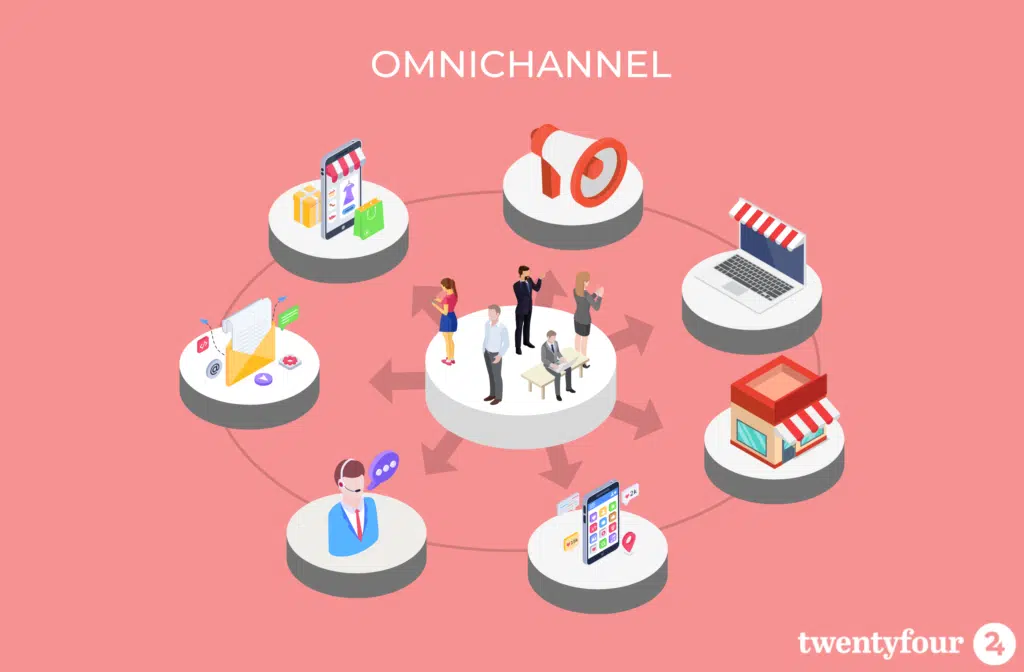Customers in the global and digital age have many choices and ways to interact with companies and brands. The line between online and physical contact points is blurred, and future companies must put on the holistic cap, look beyond platforms and channels, and instead place the customer at the center.
Omnichannel is when a company gives customers a positive and coherent user experience when presenting services and products in sales and service across channels, platforms, and devices.
The benefits of an omnichannel approach are that you can be present where your customers are when they need you. In this way, you achieve a larger contact area and reach, but at the same time, you also increase potential sales. Customers will experience higher satisfaction and show increased loyalty to your brand and company when the customer journey is coherent and personal.
Customers can shop or search for information about the company from a mobile, tablet, PC, via apps, websites, social media, or they can come to physical stores, showrooms, and offices. Subordinate to where the customer is located, the omnichannel experience must be consistent and coherent.

An omnichannel experience means that all channels are integrated. It gives the customer a coherent user experience subordinate to which channel the customer is on or directs inquiries through. Data is collected about the customer from the various touchpoints and used to personalize the experience further.
Omnichannel is marketing, sales, and customer service on all channels. This means that you can create a coherent and seamless customer experience no matter where, when, and how the customers contact you. The experience is the same in tone, visual elements, and the brand subordinate to which channel the customer chooses.
What is omnichannel marketing?
The definition of omnichannel marketing can be difficult to frame in a few words. But if you split the term up, ‘omni’ is derived from Latin and means everything or everywhere. That means it is a marketing strategy or approach that includes all the company’s channels with the goal to give the customer one overall customer experience. And it does not matter on which platform or channel the customer is located.
Omnichannel marketing is an investment. Connecting all touchpoints, channels, and platforms, thereby creating an omnichannel customer experience, will enhance the customer’s experience of your business and brand and increase engagement and sales.
It is quite a wild mission to obtain omnichannel in your marketing efforts. For a company, it is a big task to take on. The customer must be able to easily recognize the brand throughout and get the same experience on the mix of channels that the customer chooses to use. This requires collecting and using data from the customer’s interaction on platforms and channels. This data must be used to create targeted and personalized communication to the individual customer.
Omnichannel or multichannel?
Omnichannel always uses many channels, but many channels do not always equate to omnichannel. How is that so?
You have to keep your tongue straight in your mouth because many people confuse omnichannel with multichannel. And there is a slight difference!
The difference is that the channels aren’t connected in multichannel. Although the company has many channels with engaging campaigns and great content, it is not omnichannel marketing unless the channels are integrated and synchronized.

In short, the difference between multichannel and omnichannel marketing is that in multichannel marketing, you communicate on different media based upon its purpose. In multichannel marketing, the primary goal is to gain commitment and engagement from the individual customer. Today, multichannel is the approach most companies apply in their marketing strategy.
In omnichannel marketing, you communicate on different channels, which are all integrated. The primary goal of an omnichannel approach is to deliver a high-quality and value-based customer experience. Therefore, you execute your communication and marketing efforts upon the customer as the center.
Create a seamless customer journey – place yourself in your customers’ position
When talking about omnichannel, you will experience a seamless journey and brand integration when visiting online and offline customer touchpoints. As a user, you will move through the sales funnel, experiencing a coherent flow in your shopping journey.
Today, most brands and companies agree that an omnichannel approach equals the best marketing results. Centering your marketing strategy around omnichannel is no easy task – but if done correctly, it pays off.
Good examples of companies that excel in omnichannel marketing here in Denmark include Matas and Power. If we look beyond the country’s borders, some of the strongest examples are, i.a., Disney and Starbucks.
So, how do you create the framework for a seamless user experience?

Start with the primary channels in your company! Make sure these channels reflect your business tone of voice, illustrations, images, and the presentation of your products or services.
It’s more important to be consistent with your current channels rather than focus on the number of channels you want your company to be present. You can always increase the volume of channels once you’re on track with the basics.

Make sure to have a cohesive and efficient purchase process: from the research of your product or service until the purchase intent from the customer is achieved. It’s vital that you continually consider the steps in your customer journey and optimize these regarding the users’ needs.

Call-to-actions are crucial if you want to lead the customer to purchase or dialogue. Make sure to have clear and well-placed call-to-actions! It can either be a contact form, a chatbot, a phone number, etc.
Remember that the chosen call-to-action needs to have a response that matches the rest of the omnichannel experience in style and tone. Therefore, it’s essential to hold on to the seamless and cohesive customer journey.
Omnichannel is a business effort and not just a marketing effort!
In order to achieve a great omnichannel experience, it’s crucial that the whole company are ready to support the task. Therefore, the product department, sales, marketing, and customer service must all contribute to the success of a high-quality experience through the value chain.
The future is omnichannel – are you ready?
Nowadays, you need to wrap your head a little around omnichannel when working or supporting clients. And it’s not without benefits! There’s a lot for you to gain as a company when applying an omnichannel approach in your marketing efforts.
A digital presence is increasing among customers. Therefore, the companies that manage to jump on the bandwagon and make their customer experiences seamless and accessible subordinate to time and place are gaining a solid market position.
According to McKinsey, it’s beneficial for your company to adapt customer service during coronavirus.
McKinsey emphasizes the importance of accommodating customers wherever they are. The tendency, going forward, is that companies that manage to provide a more digital experience win both customers and most likely also a part of their loyalty after the corona crisis. McKinsey expects to see a permanent change in the behavior of consumers. The study already shows an increase in the consumers’ online shopping by 55%.
A selection of these customers will maintain their online shopping behavior and, therefore, will not become physical customers again. The transition from offline to online shopping was slow before Covid-19 but accelerated tremendously after the pandemic.
It requires high adaptability processes across analog and digital touchpoints. A customer-centric approach, where services, products, and purchases are connected in a coherent customer experience, will create high value for consumers in a volatile and dynamic market characterized by colossal competition.
Therefore, you should think in omnichannel
The advantages of working with omnichannel going forward are many! Below you’ll find our four main arguments for starting to implement and work with omnichannel as a part of your marketing strategy.
#1: A personalized user experience provides loyal customers
Omnichannel focuses on the individual user experience across devices. In omnichannel marketing, this means that the customer can interact with your company on different media, where you are present, as a part of a coherent customer journey.
Applying an omnichannel approach will make the customer experience significantly better and more valuable as you focus on the customer and not the platform. Furthermore, omnichannel will secure that marketing, sales, customer service, and customer touchpoints are connected, meaning the user will experience an efficient and cohesive journey across channels.
Gradually, it’s possible to shop online, in a store, via mobile, live chats. In this way, several customer needs are accommodated and fulfilled. It provides more significant customer and brand loyalty. It’s important to mention that a customer that has visited 2 to 3 of your customer touchpoints will by 90% chance make a conversion.
#2: Create a coherent brand strategy and increase your revenue
A seamless process across channels will help you build an easily identifiable brand image. In omnichannel marketing, the marketing efforts often encourage customers to interact with the company through various touchpoints, resulting in increased engagement and revenue.
#3: Get access to valuable data
When you invest in omnichannel marketing, it’s not just about your customers’ experience with your brand. Omnichannel significantly impacts your ability to identify and analyze valuable data. By analyzing customer engagement on your different channels, you’ll understand and get greater insight into your customers’ journey.
Omnichannel marketing will make it easier for you to identify how, when, and where your customers prefer to engage and which campaigns create the most value. The identifications can then be used to create more targeted campaigns that will also help you optimize your marketing budget.
#4: Get more out of your ad spend
Attribution data is used to plan future campaigns and advertising by analyzing which media and ads have been most cost-effective and influential in terms of Return on Ad Spend (ROAS) and Click per Lead (CPL). Furthermore, attribution data can provide performance statistics and insight into previous campaigns.
In short, omnichannel attribution considers that consumers go through several touchpoints before purchasing. This type of attribution measures and assesses each marketing activity’s role to achieve conversions.
A never-ending task
You’ll never reach 100% completion when aiming for a full omnichannel practice. It’s an ongoing process that you continuously should evaluate and optimize, so your marketing efforts are constantly directed to your target group. If you want to know if you’re on the right path with omnichannel, you just need to check if your customers are either satisfied or loyal.
Omnichannel marketing is a skill and talent that some pursue greatly. In Twentyfour, we would describe omnichannel as a value- and relationship-creating phenomenon, as well as a trade phenomenon. These phenomenons contain high credibility, customer service, and loyalty to comply with customer wants and needs in a market with rapid change, myriad possibilities, and competition.
Are you considering system integrations or perhaps starting your omnichannel journey?
Are you curious to hear more or want to know how to integrate your company’s system landscape so you can start creating an omnichannel experience for your customers? Do not hesitate to write or call us ????
We hope the reading provided you with some valuable insights. If there are some specific topics you think might be relevant, please feel free to throw your suggestions our way!
Get 5 take-aways for what considerations you should make when you want to start working on omnichannel

Do an exercise where your marketing activities revolve around your customer rather than your channels when organizing and planning your content, publications, and ads.

Map and understand the customers’ user journey in your company. Clarify all touchpoints, from the first search to the final purchase. Remember to incorporate digital and analog channels.

Create synergy between your online and offline presence. Make sure there’s consistency between your expressions, tone of voice, and style.

Collect and use your customer data! Access to data makes it possible to optimize the effort on the various touchpoints. You can secure that personal messages are delivered via the most optimal channel by applying data. In addition, it is possible to prioritize customers with the most significant commitment.

Create a solid relationship with your customers by making your interaction personal. It is the foundation for achieving customer satisfaction and loyalty and building long-term customer relationships.


